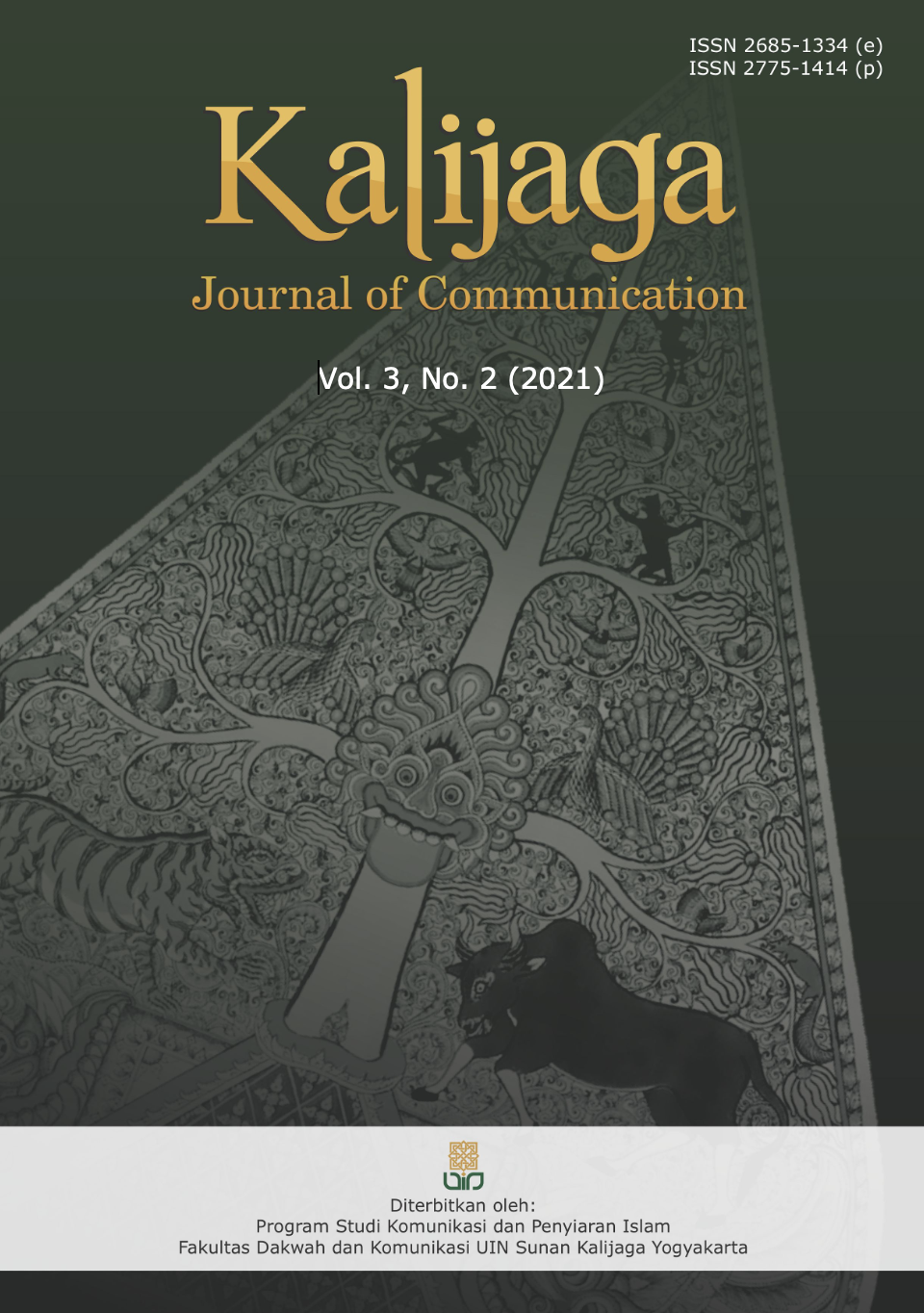Jurnalisme Dakwah di Media Online (Framing Rubrik Feature Hidayatullah.com)
DOI:
https://doi.org/10.14421/kjc.32.02.2021Keywords:
Da'wah, Journalism, MediaAbstract
As for those who are one of the "signs" that Islamic da'wah must be able to blend in with the presence of sites or news sites or news portals carrying Islamic values. The emergence of news portals that focus on the issue and point of view of Islam, becoming a trigger for introducing Islam to all corners of the world. However, the problem in this era is also whether it is properly wrapped in Islam in the internet and whether it can be said to do da'wah messages. These questions do not seem to be easily answered and concluded because there are quite a lot of online media that calls Islam, especially in Indonesia. Therefore, researchers here take one online media that has been established for a long time, namely Hidayatullah.com. It is known that the media can be said to be consistent in providing an Islamic point of view. The researcher analyzed one of the rubrics in the media, namely on the Feature Rubric in the March 2021 edition The citipulation provides an affirmation that even though the content contains coverage, can still be inserted by verses. As for those who researchers, but it is Hidayatullah.com taking a resource person who is able to motivate in increasing faith. The issues raised are also quite selective as they can provide insight into Islamic values and increase their readers' faith.
 Abstract viewed: 439 times
|
Abstract viewed: 439 times
|
 PDF downloaded = 474 times
PDF downloaded = 474 times
References
Darlis. “Mengusung Moderasi Islam Di Tengah Masyarakat Multikultural.” Rausyan Fikr: Jurnal Studi Ilmu Ushuluddin Dan Filsafat, 2017.
Djatnika, Rico Bagus. “Penyajian feature sosok inspiratif : Studi analisis framing model Zhongdang Pan dan Gerald M. Kosicki mengenai feature sosok inspiratif di media Beritabaik.id edisi Maret 2020.” Diploma, UIN Sunan Gunung Djati Bandung, 2020.
Eriyanto. Analisis Framing. Yogyakarta: LKiS, 2002.
Fahmi, Muhammad, Irwan Abdullah, Ratna Noviani, and Wening Udasmoro. “Diskursus Islam Dalam Konstruksi Media.” LiNGUA: Jurnal Ilmu Bahasa Dan Sastra 10, no. 2 (December 28, 2015).
Hakim, Lukman, and Anisah Meidayanti. “Implementasi Jurnalisme Dakwah Dalam Media Online Islam: Analisis Isi Berita VOA-Islam.Com.” Jurnal Komunikasi Islam 10, no. 1 (June 10, 2020):
Halwati, Umi. “Membongkar Konstruksi Politik Di Media Massa, Analisis Wacana Terhadap Harian Kompas Tahun 2013-2014.” Jurnal Penelitian Agama 15, no. 2 (2014).
Hamad, Ibnu. “Konstruksi Realitas Politik Dalam Media Massa (Studi Pesan Politik Dalam Media Cetak Pada Masa Pemilu 1999).” MAKARA of Social Sciences and Humanities Series 8, no. 1 (2004).
Ismail, Faisal. Islam, Doktrin, Dan Isu-Isu Kontemporer. Yogyakarta: IRCiSoD, 2016.
Kango, Andries. “Jurnalistik Dalam Kemasan Dakwah.” Jurnal Dakwah Tabligh 15, no. 11 (2014).
Qudratullah. “Peran Dan Fungsi Komunikasi Massa.” Jurnal UIN Alauddin, 2018.
Riadi, Bagus, and Diki Drajat. “Analisis Framing Gerakan Sosial: Studi Pada Gerakan Aksi Bela Islam 212.” Holistik 3, no. 1 (November 30, 2019): 10–18.
Rosyid, Moh. “Mengevaluasi Jurnalisme Online Sebagai Dakwah.” At-Tabsyir, Jurnal Komunikasi Penyiaran Islam 1 (2013).
Suciati, Titis Nurwulan, and Ratna Puspita. “Bukan Hanya Situs Berita: Ikhtisar Dan Tren Jurnalisme Online Indonesia.” CoverAge: Journal of Strategic Communication 9, no. 2 (March 18, 2019): 20–30.
Vivian, Jhon. Teori Komunikasi Massa. Jakarta: Kencana Prenada Media Group, 2018.
Downloads
Published
Issue
Section
License
Copyright (c) 2022 Eko Wahyudi

This work is licensed under a Creative Commons Attribution-ShareAlike 4.0 International License.
Authors who publish with this journal agree to the following terms:
- Authors retain copyright and grant the journal right of first publication with the work simultaneously licensed under a Creative Commons Attribution-NonCommercial-ShareAlike 4.0 International License. that allows others to share and adapt the work with an acknowledgement of the work's authorship and initial publication in this journal.
- Authors are able to enter into separate, additional contractual arrangements for the non-exclusive distribution of the journal's published version of the work (e.g., post it to an institutional repository or publish it in a book), with an acknowledgement of its initial publication in this journal.
- Authors are permitted and encouraged to post their work online (e.g., in institutional repositories or on their website) prior to and during the submission process, as it can lead to productive exchanges, as well as earlier and greater citation of published work (See The Effect of Open Access).






























